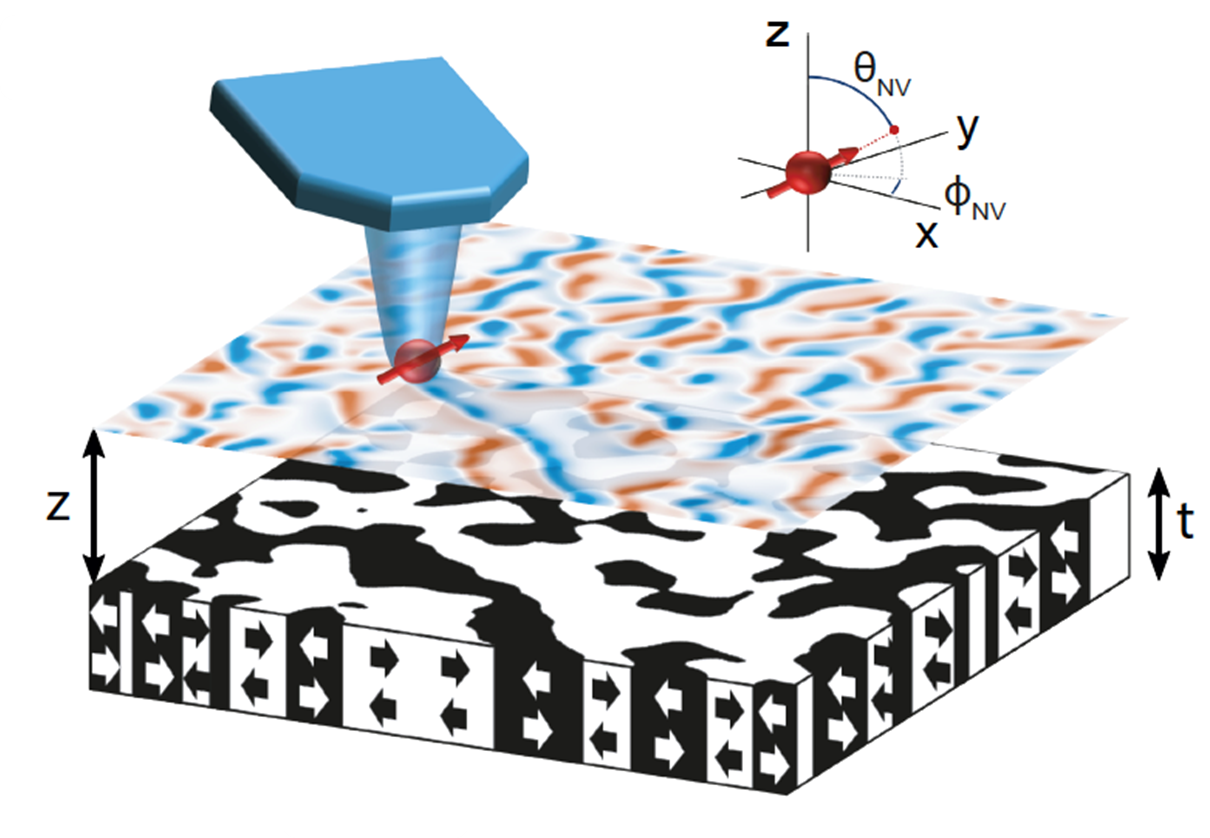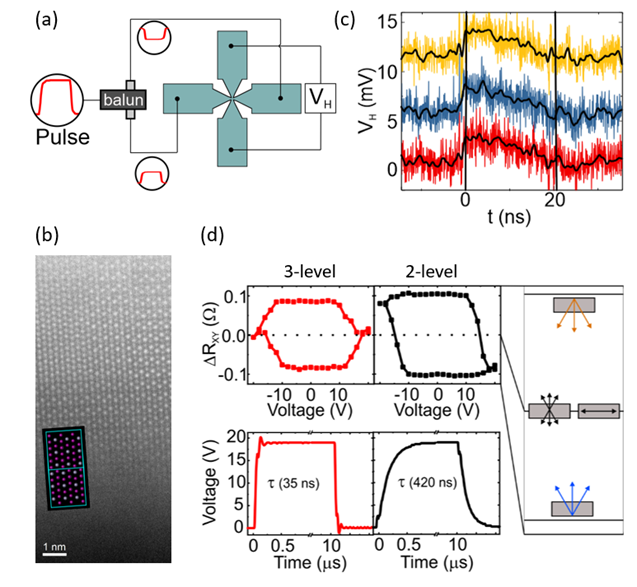Spintronics in Antiferromagnets
Antiferromagnets play a major role in condensed matter physics, not only as a specific class of magnetic materials, but also as a playground for investigating strongly correlated electron physics, terahertz spin dynamics, and exotic spin excitations. The fascination in these materials has taken an unexpected turn in the last decade, with the discovery of topological charge and spin Hall effects in compensated noncollinear magnetic systems on the one hand, and current-driven manipulation of antiferromagnetic order on the other. These phenomena have opened up a new field of research, in which antiferromagnetic order, topological band structure, and spintronic effects intersect with far reaching consequences.
Early measurements have been performed on CuMnAs, a collinear antiferromagnets in which the Mn atoms occupy inversion-partner lattice sites. Upon an injection of an electric current through CuMnAs, a local relativistic spin-orbit torque is generated which points in the opposite direction on magnetic atoms with opposite magnetic moments. The staggered relativistic torque can induce switching of the antiferromagnetic order parameter on an ultrafast timescale. High density electric currents also induce additional effects due to Joule heating, as shown, e.g., in Pt/NiO bilayers.

A very interesting material is Mn3Sn, a Weyl metal with chiral antiferromagnetic order, which exhibits anomalous Hall and Nernst effects comparable to ferromagnets as well as efficient current-induced switching of the antiferromagnetic order parameter. Strong interest in this material is also motivated by the prospects of realizing low-power and ultrafast antiferromagnetic memories, which would integrate or replace thin film devices based on conventional ferromagnets. Yet, despite the increasing attention devoted to both fundamental and applied aspects of noncollinear antiferromagnets, little is known about the mechanisms and timescales that govern the reversal of chiral antiferromagnetic order.

Our work provided the first description of the current-driven reversal of chiral antiferromagnetic order in Pt/Mn3Sn bilayers in the time domain. Hall effect measurements for current pulses with rise and fall times ranging from μs to ns reveal that antiferromagnetic switching proceeds via a two-step demagnetization-remagnetization process that lasts several tens of nanoseconds and is explained by the timed interplay of current-induced heating and spin-orbit torques generated by a Pt or W layer adjacent to Mn3Sn. We further demonstrate the occurrence of tristable or bistable switching depending on the temporal structural of the current pulses. Time-resolved measurements indicate that chiral spin rotation is either damped or incoherent in Mn3Sn. These results provide unique insight into the switching timescale and dynamics of antiferromagnets, highlighting differences with respect to ferromagnets and collinear and noncollinear antiferromagnets.
Selected publications
- Time-dependent multistate switching of topological antiferromagnetic order in Mn3Sn, G.K. Krishnaswamy, G. Sala, B. Jacot, C.-H. Lambert, R. Schlitz, P. Nöel, P. Gambardella, Phys. Rev. Appl. 18, 024064 (2022). Download article (PDF, 2.4 MB)
- Coexistence of Bloch and Néel walls in a collinear antiferromagnet, M. S. Wörnle, P. Welter, M. Giraldo, T. Lottermoser, M. Fiebig, P. Gambardella, and C. L. Degen, Phys. Rev. B, 103, 094426 (2021). Download article (PDF, 1.4 MB) Download supplementary information (PDF, 2.8 MB) Viewpoint: Hidden Magnetic Structure Revealed, Download Physics 14, s31 (PDF, 250 KB) (2021).
- Spin-orbit torque switching of an antiferromagnetic metallic heterostructure, S. DuttaGupta, A. Kurenkov, O. A. Tretiakov, G. Krishnaswamy, G. Sala, V. Krizakova, F. Maccherozzi, S. S. Dhesi, P. Gambardella, S. Fukami, and H. Ohno, Nat. Comm. 11, 5715 (2020). Download article (PDF, 2.5 MB)
- Multidomain Memristive Switching of Pt38Mn62/[Co/Ni]n Multilayers, G. K. Krishnaswamy, A. Kurenkov, G. Sala, M. Baumgartner, V. Krizakova , C. Nistor, F. Maccherozzi, S. S. Dhesi, S. Fukami, H. Ohno, and P. Gambardella, Phys. Rev. A 14, 044036 (2020). Download article (PDF, 2.7 MB)
- Systematic study of nonmagnetic resistance changes due to electrical pulsing in single metal layers and metal/antiferromagnet bilayers, B. J. Jacot, G. Krishnaswamy, G. Sala, C. O. Avci, S. Vélez, P. Gambardella, and C.-H. Lambert. J. Appl. Phys. 128, 173902 (2020). Download article (PDF, 924 KB)
- Current-induced fragmentation of antiferromagnetic domains, M. S. Wörnle, P. Welter, Z. Kašpar, K. Olejník, V. Novák, R. P. Campion, P. Wadley, T. Jungwirth, C. L. Degen, P. Gambardella, external page arxiv:1912.05287 (2019).
- Terahertz electrical writing speed in an antiferromagnetic memory, K. Olejník, T. Seifert, Z. Kašpar, V. Novák, P. Wadley, R. P. Campion, M. Baumgartner, P. Gambardella, P. Němec, J. Wunderlich, J. Sinova, P. Kužel, M. Müller, T. Kampfrath and T. Jungwirth, Sci. Adv. 4, eaar3566 (2018). Download article (PDF, 1.9 MB), Download supplementary inf (PDF, 721 KB)ormation
- Antiferromagnetic CuMnAs multi-level memory cell with microelectronic compatibility, K. Olejnik, V. Schuler, X. Marti V. Novak, Z. Kaspar, P. Wadley, R. P. Campion, K. W. Edmonds, B. L. Gallagher, J. Garces, M. Baumgartner, P. Gambardella and T. Jungwirth, Nat. Comm. 8, 15434 (2017). Download article (PDF, 882 KB)